
Back and spine problems can significantly affect daily life, causing pain, reduced mobility, and discomfort. At MM Hospital, Namakkal, our expert surgeons use Advanced Spine Surgery Techniques to help patients regain their mobility and live pain-free. Our approach ensures the safest and most effective treatment options tailored to individual needs. Here are some of the key Spine Surgery techniques we offer:
1. Laminectomy – Relieving Pressure on the Spine

Laminectomy is a common surgical procedure used to relieve pressure on the spinal cord or nerves. It is often recommended for conditions like spinal stenosis, where the spinal canal narrows and compresses the nerves. This compression can lead to symptoms such as lower back pain, numbness, tingling sensations, weakness in the legs, and difficulty walking.
During the procedure, the surgeon removes a portion of the lamina (a small bone covering the spinal canal) to create more space and reduce nerve compression. In some cases, a portion of a herniated disc or bone spur may also be removed to further relieve pressure. Patients typically experience relief from symptoms soon after surgery, and with proper post-operative care, they can gradually return to normal activities.
Recovery from a laminectomy varies from patient to patient. While some may resume light activities within a few weeks, others may require a more extended recovery period. Physical therapy plays an essential role in ensuring that patients regain strength and flexibility in their spine, reducing the risk of future complications.
2. Discectomy – Removing a Herniated Disc
A herniated disc, also known as a slipped or ruptured disc, occurs when the soft inner material of a spinal disc pushes through its outer layer, pressing against nearby nerves. This can cause severe pain, numbness, or weakness in the back, arms, or legs, depending on which part of the spine is affected.
Discectomy is a surgical procedure designed to remove the damaged portion of a disc to relieve pressure on the nerves. In many cases, minimally invasive techniques are used, involving small incisions and specialized instruments to reduce trauma to surrounding tissues. Minimally invasive discectomy leads to a quicker recovery, less post-operative pain, and a lower risk of complications.
Following surgery, patients are advised to follow a structured rehabilitation program, including exercises to strengthen the spine, maintain flexibility, and prevent further disc issues. Proper posture and ergonomic adjustments in daily life also play a crucial role in long-term spinal health.
3. Pedicle Screw Fixation – Stabilizing the Spine
Pedicle screw fixation is a surgical technique used to provide stability to the spine, particularly in cases involving spinal fractures, scoliosis, degenerative conditions, or spinal instability following decompression surgeries. This method involves the insertion of screws into the vertebrae, which are then connected with rods to hold the spine in proper alignment and promote healing.
There are two main approaches for pedicle screw fixation:
Anterior Pedicle Screw Fixation – The surgical approach is from the front of the spine, often used in cases requiring extensive reconstruction. It is commonly performed for conditions affecting the cervical or lumbar spine where direct access from the front allows better correction of deformities and reconstruction of the vertebral column.
Posterior Pedicle Screw Fixation – The approach is from the back of the spine, which is more commonly used for spinal fusion surgeries. This method provides strong stability and is frequently performed in combination with other spine procedures such as decompression or corpectomy.
Patients who undergo pedicle screw fixation usually require a period of restricted activity to allow proper healing. With time and rehabilitation, most patients regain their mobility and experience significant pain relief.
4. Decompression Surgery – Alleviating Nerve Pressure
Decompression surgery is performed to relieve pressure on the spinal nerves caused by conditions like spinal stenosis, herniated discs, bone spurs or tumors. When nerves are compressed, they can cause symptoms such as chronic pain, difficulty walking, numbness, and even loss of bladder or bowel control in severe cases.
By removing portions of bones, ligaments, or disc material, surgeons create more space for the nerves, reducing pain and discomfort. Decompression techniques often include laminectomy and discectomy, depending on the patient’s condition. This procedure is highly effective in restoring movement and comfort.
Patients undergoing decompression surgery can expect a gradual improvement in symptoms. Physical therapy and post-surgical rehabilitation are essential for strengthening the spine and preventing complications. Doctors often recommend lifestyle changes such as weight management, ergonomic adjustments, and regular exercise to maintain long-term spine health.
5. Corpectomy – Reconstructing the Spine
Corpectomy is a specialized procedure used in cases where significant portions of the vertebrae need to be removed due to trauma, tumors, infections, or severe degeneration. The affected bone is replaced with a graft or an artificial implant to maintain spinal stability.
This procedure is more complex than other spine surgeries and requires careful planning. Corpectomy is often performed in combination with spinal fusion to ensure that the spine remains stable after the removal of the damaged vertebrae. Patients who undergo a corpectomy may require a longer recovery period, but with appropriate rehabilitation, they can regain mobility and experience long-term relief.
Recovery and Post-Surgical Care
At MM Hospital, Namakkal, we ensure that every patient receives personalized post-surgical care. After spine surgery, patients undergo a tailored rehabilitation program that includes:
Physical Therapy – Helps in regaining strength and mobility. Targeted exercises improve flexibility and reduce stiffness.
Pain Management – Medications and therapies are provided to ease discomfort and promote healing.
Lifestyle Adjustments – Guidance on posture, activity modification, and exercises to prevent future spine issues. Simple changes like using ergonomic chairs, maintaining a proper sleeping position, and avoiding heavy lifting can significantly impact recovery.
Follow-Up Care – Regular check-ups with our spine specialists ensure that healing progresses as expected and any concerns are addressed promptly.


